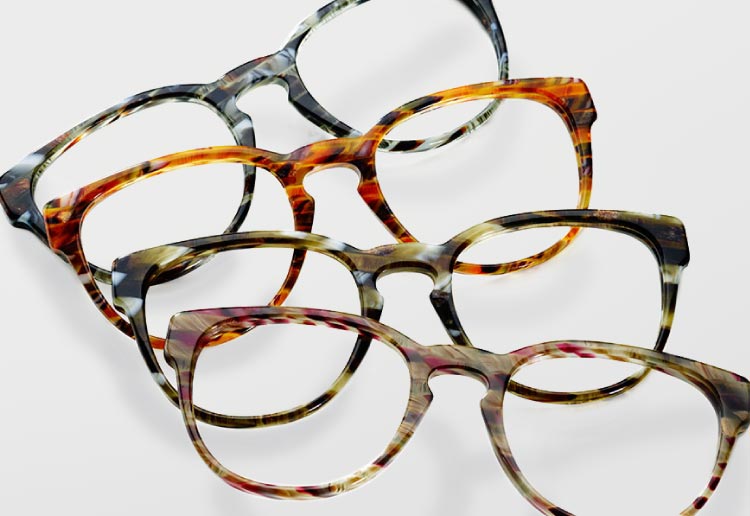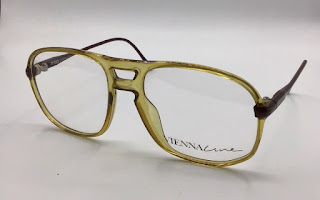Plastic Frame Materials
The first classification of a frame is by the material used in its construction: either plastic or metal. Several types of both are used to make frames.
The first plastics used for spectacle frames were made from bakelite and galalith.
These did not perform well in cold weather because of their brittleness. Later cellulose nitrate (zylonite) was widely used. Cellulose nitrate accepts a good polish, but is flammable if brought to a sufficiently high temperature. Because of the danger posed, cellulose nitrate has been banned by the FDA and is no longer used for spectacle frames. However, because these zylonite frames were the only plastic frames commonly used for a period of time, plastic frames were known as “zyl” frames. In spite of zylonite disappearing from the market, the “zyl” nickname for plastic frames remained. Now that nickname is primarily used to refer to cellulose acetate material.
Cellulose Acetate
A material used extensively for spectacle frames is cellulose acetate. The basic cellulose material may be extracted from cotton or wood pulp and then further processed. When derived from cotton, the material used is the fiber that adheres to the cottonseed after ginning and is too short to be used for making textiles. These fibers are called cotton linters.
This cotton or wood material is treated with a mixture of anhydride and acetic acid using sulfuric acid as a catalyst. Plasticizers and aging stabilizers are then added to this material.
Nevertheless, cellulose acetate does become brittle with age. Some allergies are attributed to wearing cellulose acetate frames, though this is rare. More often skin problems are not so much allergic reactions to the material itself, but to those things which can be absorbed by the material. Higher quality cellulose acetate frames are coated in order to seal the surface. When left uncoated, cellulose acetate may absorb materials which might be allergen producing. A good frame coating will contain a UV inhibitor. This inhibitor in the coating keeps frame color from fading. Cellulose acetate can be formed into sheets of plastic from which frame parts can be cut, or it can be made into acetate granules that are used for injection molding. For spectacle frames, cellulose acetate is generally made into sheets and milled.
Propionate
Cellulose acetopropionate, more commonly referred to as propionate, has many of the same characteristics as cellulose acetate and works better for injection molding. Propionate has less color stability than cellulose acetate and, unless it is covered with a high quality framecoating material containing UV absorbers, will fade within a relatively short period of time.
Propionate frames are made beginning with granules of the material that are heated until liquid, then injection molded to the desired frame shape. Granules may initially be colorless, allowing the frame parts to be dyed to the desired color after they have been molded. Propionate has a slight weight advantage over acetate, in that it is about three quarters of the weight.
Optyl
Epoxy resin is used for spectacle frames and is known under the trade name of Optyl. A liquid resin and a hardener are mixed together and drawn into the frame molds using a vacuum process. The material is thermoelastic. This means that it will bend when heated and will return to its original shape when reheated.
Optyl is approximately 30% lighter than cellulose acetate. Because of its stability, Optyl is appropriate for those who might be allergic to other types of frame materials.
Nylon and Nylon-Based Materials
Nylon. Nylon is a material of high fl exibility. When used alone in spectacle frames, nylon will lose that flexibility unless periodically soaked in water overnight. Otherwise, over time, it will become brittle. “Pure” nylon was previously used extensively for sports eyewear. It has also been used for over-the-counter sunglasses.
It is now being combined with other material for added strength and stability, remaining a part of the array of frame materials in use.
Polyamide/Copolyamide.
Polyamide is a nylon-based material that is quite strong. Because it can be made thinner and is only 72% of the weight of cellulose acetate, polyamide has a real weight advantage. Polyamide frames can be made opaque or translucent. Frames made from polyamide are resistant to chemicals and solvents, and are also hypoallergic
Grilamid.
Grilamid is a nylon-based material used in sports and performance type of eyewear. Unlike plain nylon frame material, grilamid has a large variety of color possibilities. Some manufacturers have fused Grilamid with titanium to create a strong, comfortable variation of this frame material.
Carbon Fiber
Carbon fiber material is used to create a thin, strong frame. This material is made from strands of carbon fibers combined with nylon. It is not adjustable and is consequently used mainly for frame fronts. The temples are generally made from another material. In other words, if a carbon fi ber frame does not fi t well in frame selection, do not plan on making it fi t well later on. The principle advantage is the light weight that can be achieved. Carbon fi ber is 60% the weight of cellulose acetate. Not only is the material light weight, but because of its strength, it can also be made thinner. Since carbon is black, frame colors will be opaque and are limited.Some problems may be encountered with breakage in cold weather. Because of the thermal problems, it is imperative that the material not be directly worked with right after it has been outside. (For more information on working with carbon fiber material
Polycarbonate
Polycarbonate is a material usually associated with lenses, but can be molded into frames. Frames made from polycarbonate are primarily for sport or safety purposes. When made for nonprescription purposes, the lenses and frame are molded as one unit.Frames (and lenses) made from polycarbonate are very impact resistant. Unfortunately, polycarbonate frames do not work well for conventional eyeglasses because of their resistance to adjustment. They are better suited for the type of sports glasses that are held in place with elastic straps or for shield types of glasses that may be used either alone or worn over conventional glasses.
Kevlar
Kevlar is a material that is also mixed with nylon. It, too, is a strong, lightweight ophthalmic frame material. Kevlar will remain stable over a large temperature range, but is difficult to adjust. Although it becomes pliable with heat, it will not shrink or stretch.
Rubber
Some sports eyewear and sunglass frames may be made from a combination of nylon and rubber. As would be expected, these frames are fl exible and will return to their original shape, but are not adjustable.
Combinations of Plastic Materials
There are numerous possible combinations of plastic materials. These include materials sometimes called memory plastics.
Memory plastics are tough and flexible. They can be bent or twisted and still return to their original shape.Not all composite plastic materials are memory plastics. Other composite plastics combine various materials to produce frames and frame parts for specifi c needs and purposes.
OPTOMETRY-SHARP VISION
Optometrist





